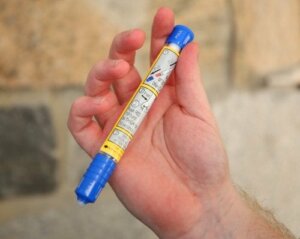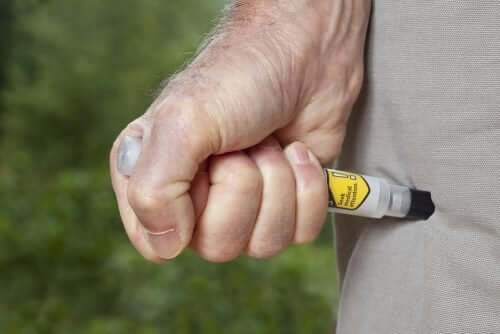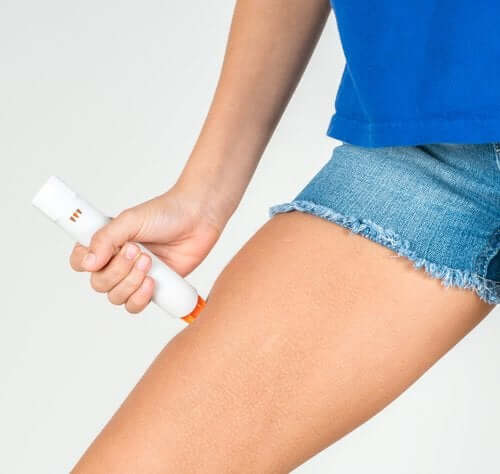Self-Injectable Adrenaline: How to Use It

Adrenaline is a hormone and a neurotransmitter that others use when someone has a heart attack. There are several ways to administer adrenaline, but nowadays we have self-injectable adrenaline.
This device allows us to inject ourselves with adrenaline without the need for the intervention of a health care worker.
This fact has allowed us to avoid many fatal situations. Adrenaline is generally used in emergency situations, where the patient’s life is in great danger from cardiac arrest or anaphylactic shock.
Self-injectable adrenaline is a device that contains adrenaline in solution form, which is subject to a doctor’s prescription. There are two formats available with two different doses:
- 0.15 mg dose: recommended for children who weigh from 22 to 55 pounds (10 to 25 kg)
- 0.30 mg dose: recommended for people who weigh more than 55 pounds (25 kg)
Adrenaline is able to increase the heart rate considerably, as well as contracting the blood vessels and dilating the airways. It’s also the neurotransmitter that’s rapidly secreted in situations of danger and emergency and which prepares the body to handle any extreme situation.
It’s important to know that adrenaline is, specifically, a catecholamine. Its chemical structure is a monoamine that synthesizes in the adrenal glands and its precursors are phenylalanine and tyrosine.
Ways of administering adrenaline

Before we focus on self-injectable adrenaline, let’s look at other ways to administer this medication.
In hospitals, specialists prepare catecholamine as a solution that anyone can administer with an injection. However, there are more routes available:
- Intramuscular (IM)
- Subcutaneous
- Intravenous (IV): under cardiac monitoring and previously diluting the adrenaline solution in water for injection in different concentrations as needed.
- Intracardiac: only in cases of extreme severity and if the intravenous route is not practical. The same precautions should also be taken as for when you administer through the intravenous route.
Discover: The Release of Adrenaline: the Activation, Stress, and Headache Hormone
How does self-injectable adrenaline work?
On the market, there are two different brands under which we can find self-injectable adrenaline: Altellus and Jext.
Both have a cylindrical shape, similar to a pen. At one end of this cylinder there’s a protected needle that’ll be used for administration. At the other end of the cylinder is a safety cap that must be removed at the time of administration.
When you insert the needle (after you’ve removed the safety cap from the other end), the needle comes out and penetrates the area where you need to inject the substance. However, we’ll tell you exactly how to use it.
Also read: How to Make a Travel First Aid Kit

Steps for self-injecting adrenaline
The recommended area to inject the adrenaline is in the thigh, even if it’s through clothes, as it’s an area with a lot of muscle mass.
You’ll press down until you hear a click, ensuring that the needle will reach the muscle and can be absorbed and distributed correctly. Afterwards, hold the injectable for 10 seconds. After this time, remove the needle and massage the area to facilitate absorption.
These are the steps to follow for the correct use of the self-injectable adrenaline:
- Grasp the cylinder with your hand, as if it were a dagger.
- Remove the cap that’s located in the widest part of the device.
- Press the narrow part of the device against the thigh, where there’s more muscle mass. You can even do this through clothing.
- Press perpendicularly until you hear a “click”. You can also administer it by jabbing it, instead of applying pressure.
- Hold the position for about 10 seconds to ensure you administer the entire dose.
- Withdraw and massage, as we’ve said, for another 10 seconds to improve the absorption of adrenaline.
Children at risk, family members, and caregivers should know how to use self-injectable adrenaline in order to avoid further complications.
Conclusion
Adrenaline is a drug that the patient can receive via different routes. The route will depend on the condition of the patient and it’s usually for the treatment of cardiac arrest and anaphylactic reactions.
There are self-injectable adrenaline formulations that a physician can prescribe for the immediate treatment of anaphylactic shock.
Visit a medical professional and ask them all the questions you have in order to clearly understand how to administer adrenaline in the correct way.
All cited sources were thoroughly reviewed by our team to ensure their quality, reliability, currency, and validity. The bibliography of this article was considered reliable and of academic or scientific accuracy.
- Cardona Dahl, V. (2011). Guía de actuación en anafilaxia. Medicina Clínica. https://doi.org/10.1016/j.medcli.2010.10.003
- Comité de Medicamentos de la Asociación Española de Pediatría. (2015). Adrenalina. In Pediamécum.
- Morales-Cané, I., Valverde-León, M. D. R., & Rodríguez-Borrego, M. A. (2016). A adrenalina durante parada cardíaca: Revisão sistemática e meta-análise. Revista Latino-Americana de Enfermagem. https://doi.org/10.1590/1518-8345.1317.2821
This text is provided for informational purposes only and does not replace consultation with a professional. If in doubt, consult your specialist.








